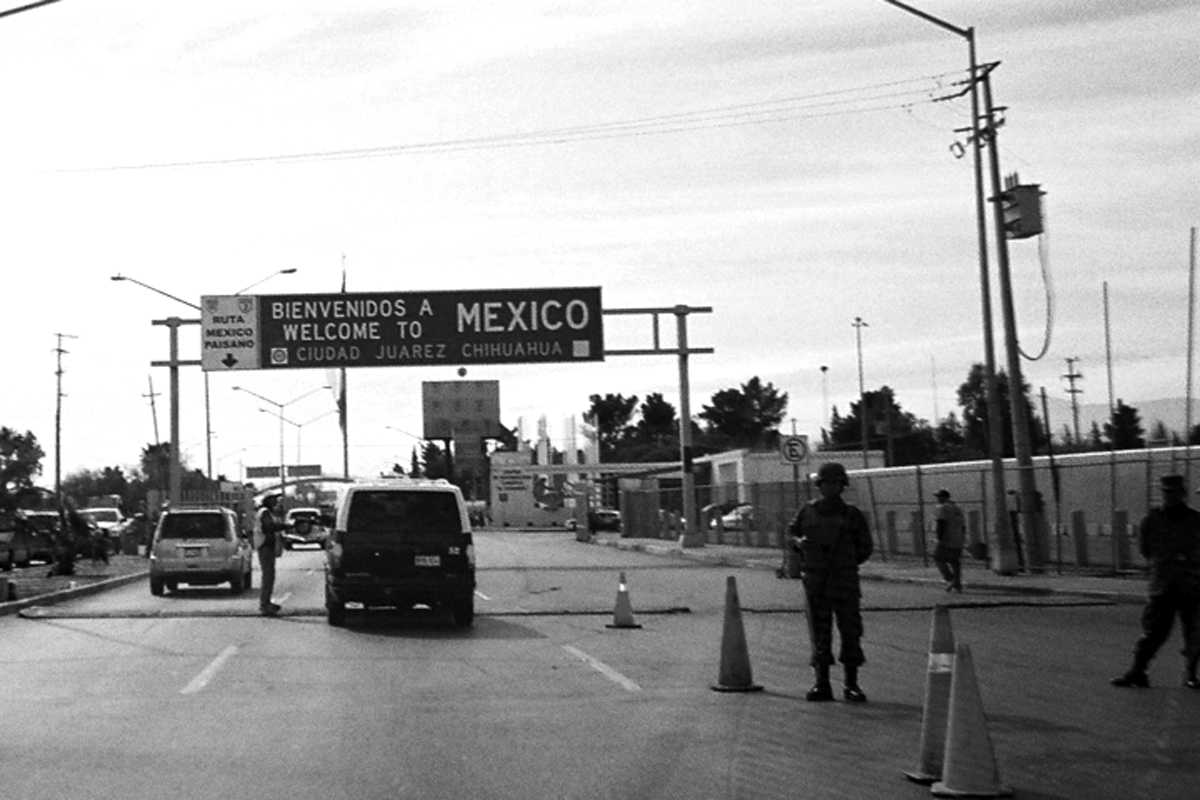
by René Kladzyk, Department of Geography
July 16, 2010: I squeeze into a bar in El Paso that sits near the university, a ten-minute drive from the downtown “Paso del Norte” bridge—a thirty-minute walk. It is a Friday night, and all the kids here are from Juárez. It is hot, loud, and packed—barely room to stand, let alone dance or hold a conversation. My friend Inez and I shout at one another—she too is from Juárez, and seems to know everyone. It’s a big city, but this is a small enough scene, I presume. Outside the bar, cars occupy every possible space, and the majority of them are “fronchi” cars. Fronchi, an abbreviation of “Frontera Chihuahua” imprinted on Juárenses’ license plates, makes discerning the national distribution of a place fairly easy.
This is not a “nice” bar, per say, but everyone is dressed to kill. It is a sea of black; black lace and black heels and long black hair mark so many beautiful young women. Black gelled curls, black rimmed glasses, black tattoos adorn laughing boys. Why do I call them boys and not men? I suppose they remind me too much of my younger brothers to evoke some stature of manhood to me, talking about playing guitar and video games. Why do I call them women? How could I not? Feminine sexuality is discernible from somewhere deeper than skin-tight garments and dark lipstick; the movements and energies of the women here are very conscious and grown up. But they are kids nonetheless, the whole lot of them. What does youth mean anyway, when your world is dying? Can you call a year a year if you live each day as though it’s your last?
Together, El Paso, Texas and Ciudad Juárez, Chihuahua comprise the largest binational metropolis in the world. While El Paso was recently ranked the safest large city in the United States, escalating violence in Juárez has placed it among the world’s most dangerous locales. We frequently conceive of the U.S. and Mexico borderlands in terms of difference, emphasizing political and economic barriers imposed by transnational forces; however, the goal of my master’s research project is to reveal and share the stories of interconnectivities among fronterizos (or borderlanders) in this tumultuous urbanism. During the winter and summer of 2010, I conducted some thirty-one interviews of women in El Paso and Juárez, whose lives straddle the borderline. Using local maps to frame our dialogue, we discussed how patterns and perceptions of day-to-day mobility have shifted due to the rampant lawlessness of Juárez. I spoke solely with women in order to shed light on gendered aspects of mobility in this area (which carries a grim history of gender-based violence), and to reflect upon the ways in which women in particular are maneuvering through public spaces.
By identifying shifts in fronteriza daily geographies, I work to demonstrate how borderlander identity is shifting in this context of militarization and impunity. I hope to convey the resilience and humanity of those who are frequently lumped in as faceless casualties of the “drug war,” paying keen attention to the living, and highlighting the myriad ways in which perceptions, experiences, and seemingly mundane choices are being influenced by the complex geopolitics embedded in this international cityscape. As part of my discussion of emerging border identities, I focus on upper-class Juarense youths who now are a fixture of El Paso nightlife. Termed “Ninis,” short for “ni trabajan ni estudian” (meaning “they neither work nor study”), this category refers to those not following the typical trajectory of adulthood, and is gaining increasing attention in Mexico with estimates of as many as eight million Ninis in the nation (AP, 2011). Although Ninis are more commonly discussed in terms of lower class as targets of cartel recruitment, I have become interested in upper class Nini culture, and how it is performed on the moonlit streets of El Paso.
The stories of this burgeoning demographic, particularly those of Juarense youth and their nightly escapades in El Paso, provide valuable insights into livelihoods of reaction and resistance produced through Mexico’s current crisis, demonstrating how altered patterns of movement can become translated into a sense of self, collectively redefining a place. This project will discuss what Nini subculture, marked by attitudes of violent nihilism and patterns of excess, can tell us about local visions of the future. More broadly, by focusing on gendered mobilities in the U.S. and Mexico borderlands, my study engages with cultural implications of the recent drug-conflict fueled exodus from Juárez into El Paso, articulating the negotiation of identities and daily geographies that characterize the double life of the borderlander.
René Kladzyk is a second-year master’s student in the UO Department of Geography, concurrently pursuing a graduate certificate in nonprofit management through the Department of Planning, Public Policy and Management (PPPM). She completed her fieldwork from June–August 2010 with the support of CSWS and the Center for Latino/a and Latin American Studies, and received a SYLFF Graduate Fellowship for International Research for the 2010-2011 academic year, during which she has been composing her thesis.

